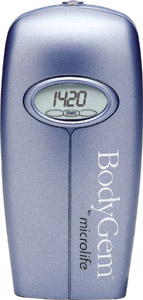 The Microlife BodyGem and MedGem indirect calorimeters measure Resting Metabolic Rate, to help Bariatric Doctors, Nutritionists, Dietitians and Personal Trainers; optimize the weight management results of their clients.
The Microlife BodyGem and MedGem indirect calorimeters measure Resting Metabolic Rate, to help Bariatric Doctors, Nutritionists, Dietitians and Personal Trainers; optimize the weight management results of their clients.
Microlife Medical Home Solutions is assisting physicians’ and their medical practices with implementing a patient-centered, physician-guided approach to an improved evaluation, diagnosis and treatment of cardiovascular, pulmonary, and metabolic diseases.
The MedGem and BodyGem Indirect Calorimeter by Microlife is a handheld, portable indirect calorimeter that measures oxygen consumption (VO2) and RMR.
.
Here’s a list of Factors That Affect Your Resting Metabolic Rate
Body mass
A person with a greater body weight will have a higher resting metabolism than a smaller person because their body has to work “harder” to support and maintain the extra weight.
Body composition
Muscle burns more calories than fat, even at rest. The literature indicates one kilogram of muscle expends 3-5 times more calories than one kilogram of fat.
Age
Metabolism declines naturally in adults at a rate of about 2-3% per decade because of loss of lean muscle mass.
Gender
Men normally have a higher metabolism than women primarily because of body mass and body composition.
Hormones
Certain hormones can increase or decrease metabolism. For example, lower than normal thyroid levels can result in approximately 15% decrease in resting metabolism and it is estimated that there may be up to a 5% increase in resting metabolism during the luteal phase of a woman’s menstrual cycle.
Nutritional supplements
Certain supplements can increase or decrease metabolism. Ephedrine can increase resting metabolism 3-16% in doses ranging from 0.25 mg to 150 mg per kilogram of body weight per day. Research studies conclude that consuming caffeine in differing amounts between 5 mg to 100 mg per kilogram of body weight per day increases resting metabolism up to 7%.
Nicotine
Tobacco products can increase resting metabolism from 3-7%.
Pharmaceuticals
Prescription and over the counter drugs can increase or decrease metabolism. It is recommended to measure individuals who are taking medications for chronic conditions i.e. (hyperlipidemia, hypertension, diabetes, etc.) as their physiology will reflect the medication. Do not measure individuals who are taking medications for acute conditions i.e. (bronchitis, sinusitis, etc.).
Fever and/or infection
An increase in body temperature will increase metabolism. The body is expending more energy to help combat an illness or injury resulting in a significant increase in resting metabolism.
Stress/emotional excitement
Good and bad stress could cause an increase in metabolism due to an increased utilization of stress hormones epinephrine and norepinephrine (catecholamines). The release of these hormones is due to an increase in heart and respiration rate.
Exercise
Strength training can lead to a chronic increase in metabolism because of the increase in lean muscle mass. Aerobic exercise does not appear to have a chronic effect on resting metabolism. Cardiovascular exercise will increase total energy expenditure in a day, but will not increase resting metabolism over time.
Weight loss
The two main reasons for a decrease in resting metabolism are that (1) a smaller body requires fewer calories to maintain the same physiological functions; and (2) during weight loss the body may try to conserve energy in response to a lower calorie intake. It is important to continually monitor metabolism during a weight loss program.
Caloric restriction
Restrictive diets consisting of less than 1000 calories per day can result in an acute decrease in resting metabolic rate. Use caution when designing calorie plans below individuals’ measured resting metabolism.